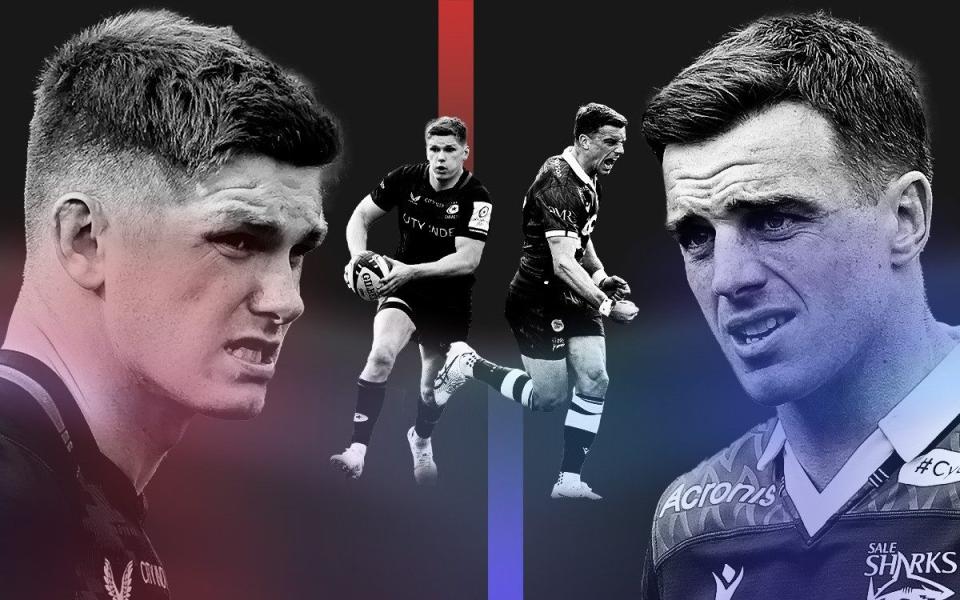
Most bright-minded individuals agree that rugby union should amplify the buzz that surrounds star players. By extension, it feels like a constructive exercise to promote head-to-heads. And the Premiership final, as Owen Farrell and George Ford lock horns, provides an opportunity too good to waste.
Age-grade team-mates since their mid-teens and acquaintances even before that, they have now accrued an aggregate of 187 England caps. Even before one considers the context of a forthcoming World Cup, this is a fascinating match-up. A number of critical battlegrounds will determine the outcome of Saracens against Sale Sharks, the box-office back-row tussle between Ben Earl and Tom Curry among them. The set-piece and breakdown scraps could also mitigate the backs to a certain degree.
But Farrell and Ford, both so obviously poised to become full-time coaches in later life, pilot their respective teams like American football quarterbacks. Although comparing rugby union and the NFL is generally futile, a Super Bowl would not miss the chance to hype up this pivotal positional battle.
It will be the 11th Premiership fixture between Farrell and Ford. Thus far, the former has ended up on the winning team six times. There has been a single draw, with Ford taking three victories including the two most recent meetings. For further context, though, Farrell left the field with Saracens leading 12-3 in October 2021, only for Leicester Tigers to overhaul their visitors in the last 10 minutes and triumph with a penalty try.
Last year at Twickenham, Ford suffered his Achilles injury early in the second quarter with Tigers trailing 3-0. Freddie Burns joined the fray and immortalised himself. Having guided Sale past Leicester in the semi-final, with Alex Sanderson describing him as a “pocket of calm” amid the chaos, Ford will be itching to play a more meaningful role this time.
Jamie George, the Saracens hooker, labelled the fly-half duel as “the battle of the minds” this week. Ford was lauded as a “little master” who has “transformed” Sale this season. Respect between the camps is clear. Over the past few years, Ford has been vocal in his view that playmakers mature and improve with age. What has been so intriguing about tracking the careers of him and Farrell is that they have appeared to drive one another on, rounding out their games along the way. That makes Saturday all the more compelling.
Running the show
“You can talk about trying to get to Fordy, but that’s very hard – very hard – because his running game is underrated,” Mako Vunipola says. “Just because he doesn’t use it that much, doesn’t mean he doesn’t have one. As a team, we’ve got to try and take him off his game, but that’s a lot easier said than done.”
Few players make the phrase ‘game management’ more tangible than Ford. In the past, he has spoken about governing subtle momentum swings in games, perhaps by kicking into space behind an opposition wing. We will come to those cat-and-mouse territorial exchanges later. Ford can also sting sides by scuttling through gaps.
Tom Roebuck’s try in the semi-final was a prime example of how Ford can conduct an attacking sequence that eventually overwhelms a defence. One key moment comes here, after Akker van der Merwe has been brought down out wide. Ford is scanning the Tigers front line. Note the three Sale forwards that will form a flat pod of three:
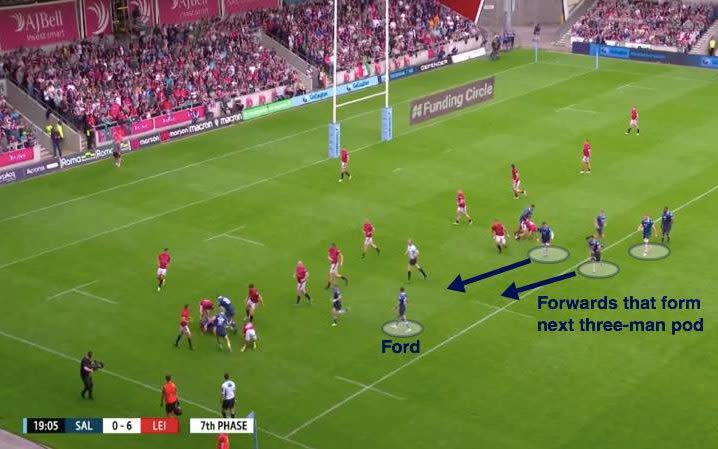
Seconds later, no doubt organised by Ford, Curry, Nick Schonert and Jean-Luc du Preez are stationed in front of their fly-half. Ford begins circling behind Schonert, the first-receiver, and towards the hole between Hanro Liebenberg and George Martin:
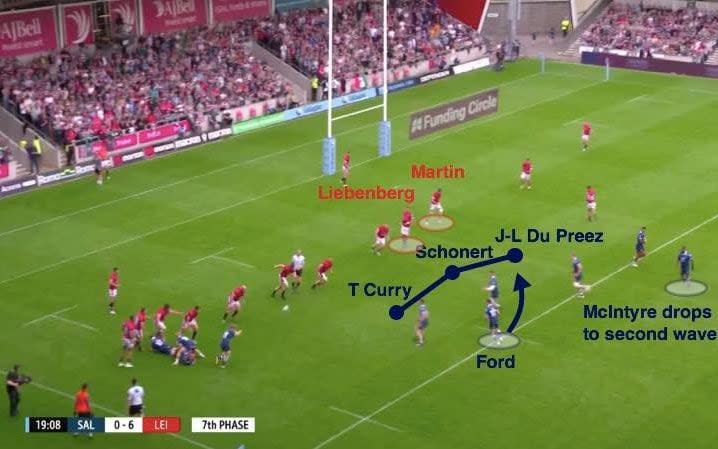
Following Schonert’s pull-back, and with Si McIntyre for company in a second wave to hold Martin, Ford darts at the line. Liebenberg readjusts well to drag down his former colleague…
…but Sale keep coming. Curry picks and offloads to brother Ben on the next phase. After that, Ford steps up at scrum-half to feed Rob du Preez and Sale’s roaming back three create the telling overload:
This attacking shape has been sharpened by Ford and the scamper from second-receiver is reminiscent of his crucial try for Leicester against Northampton Saints last season:
Speaking of breaks from second-receiver against Northampton, Farrell conjured a similar moment in the StoneX Stadium semi-final. This passage has a rather odd beginning.
One key to Saracens’ attacking expansion has been how they have stayed patient and worked hard to create depth before building momentum. Here, Farrell takes the ball standing still and drops it off to Nick Tompkins, almost resetting the sequence:
On the next phase, as Ivan van Zyl distributes, the shape is there. George stands in the middle of a three-man pod with Hugh Tizard and Maro Itoje on either shoulder. They are set reasonably deep, allowing them to build up speed. Farrell is nestled in behind them with Max Malins on his shoulder.
Closer to the near touchline is Jackson Wray, with Alex Goode and more backs filling in out wide:
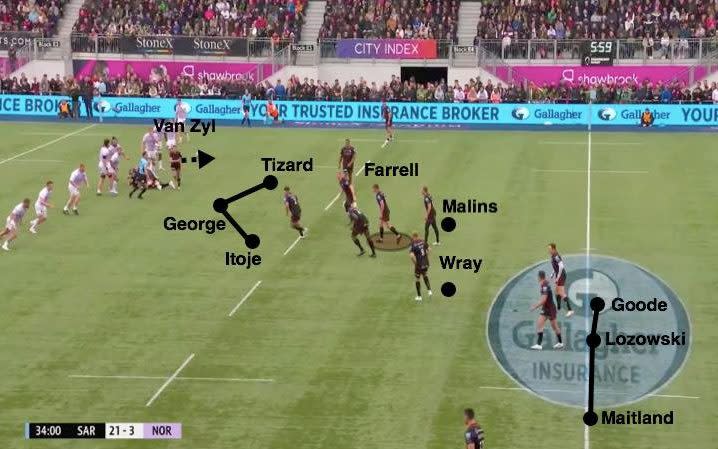
After taking the ball and approaching the line, George can play a tip to Itoje or a pull-back to Farrell. If the latter option is taken, Farrell has both Malins and Wray to feed. But the body language of Juarno Augustus clearly catches his eye:
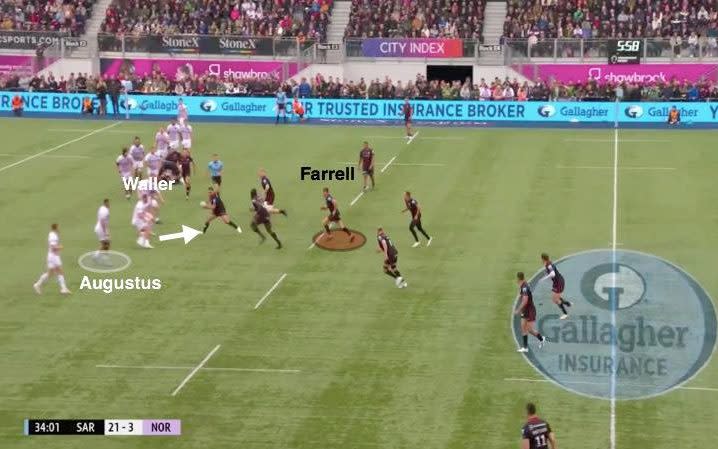
Instead of standing and delivering, as he had done seconds earlier, Farrell accelerates onto the pass of George and slices between Alex Waller and Augustus. To nit-pick, an inside pass to either Wray or Van Zyl, rather than a longer one to Sean Maitland, would probably have resulted in a try:
In both of these cases, space is created for Farrell and Ford by the number of bodies in motion around the playmakers as part of an attacking shape. The influence of their respective backgrounds in rugby league has not left either man.
Picking passes
Sanderson will implore aggression from his Sale side, yet Tom Curry knows the danger of over-eagerness when Farrell is pulling the strings.
“He likes to have people inside and outside to sit down defenders,” Curry said of his England team-mate last week. “When he’s playing at his best, he’s flat at the line and he can throw that fast ball that zips across. If your defence doesn’t have enough depth, that can stick people and create one-on-ones.”
This is a prime example, from Saracens’ heavy win over Leicester at the beginning of this season. Farrell stands at first-receiver with Theo McFarland on his left and three more runners – Billy Vunipola, Tompkins and George – to his right.
Farrell fizzes the ball across Vunipola and Tompkins to George. Jimmy Gopperth, fixed by those first two runners, cannot readjust quickly enough and George goes through before sending Malins over the try-line:
Ford is potent at the gain-line as well. Here, against Tigers in the semi-final, albeit from a deeper position, he holds the ball up just long enough for Matt Scott to bite onto him. A gap is teased open for an arcing Roebuck to take. Only some defensive heroics from Dan Kelly to bring about a spill saves Leicester:
Farrell has hinted at how Saracens’ attacking performance against La Rochelle in the Champions Cup frustrated Mark McCall’s side because they lost their nerve. Martin Gleeson, the former England attack coach, explains that attacking systems hinging on shape, such as those of Saracens and Sale, require bottle. Farrell possesses bottle in more ways than one.
“To pull teams apart through shape, you have to be brave,” Gleeson says. “You have to be direct at times and you have to run into big men.
“You won’t get a more attack-minded player than Faz. Just because he doesn’t do a hop, skip and a jump and beat people himself, doesn’t mean he doesn’t want to attack. He’s not going to get the ball on his own 22, beat five people and score a try, but that doesn’t mean he’s not an attacking brain.
“He sees things; he sees space. Why do you think Max Malins has made so many breaks this season? When they’re pulling it out the back, who do you think is making those calls?
“Shape and speed is a case of horse and cart. If you want to play quick, unless you have big carriers like André Esterhuizen or Jonathan Danty, you need to pick teams apart with short passes and good running lines. Then you get quick ball, then you’re off.
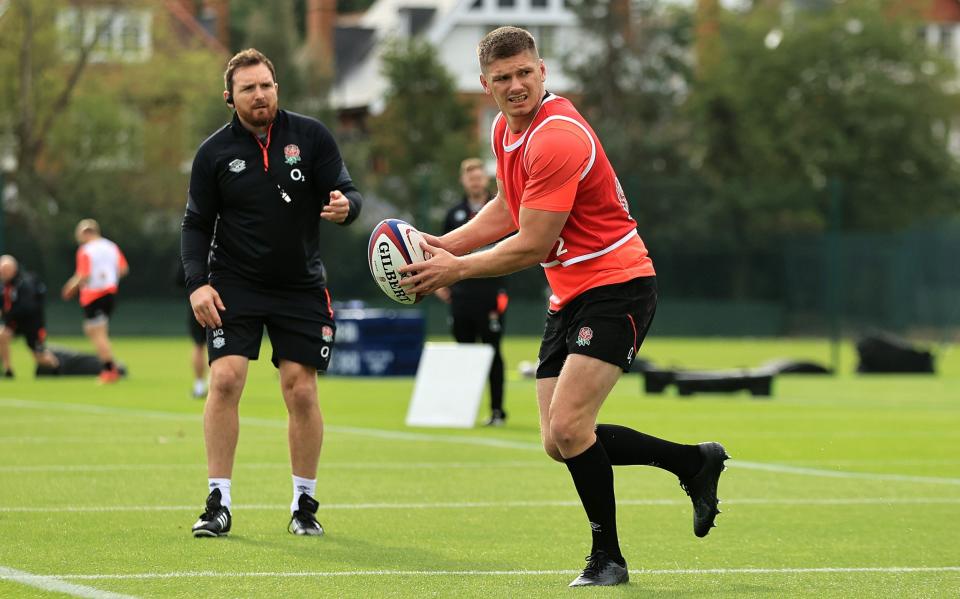
“Faz has no negative thoughts in his head regarding the game. He’ll be pragmatic. If the team is going nowhere, he’ll put up a high ball. But if you put Owen Farrell in the Ireland set-up with the shape they play, he’d absolutely carve it. He runs the show at Sarries and is a big driver of positive attack.”
Gleeson believes that Ford’s influence has enhanced Sale in the same way, with this Premiership campaign as a whole rewarding the clubs that have added dimensions to their attack. Auxiliary ball-players are hugely important. Farrell leans on Elliot Daly, Alex Goode and Malins as Ford will use Rob du Preez and Sam James.
Attacking efficiency will have a big say in deciding the final. That said, unlike NFL quarterbacks, Farrell and Ford will not be able to take a breather when their teams are without possession.
Defensive presence
According to Opta data, Ford has averaged 10.2 tackles per 80 minutes this season, completing 88 per cent of those he has attempted. Farrell has averaged 10.6 at a completion rate of 87 per cent. While those figures are similar, the manner of Farrell’s is far more aggressive.
Tom Pearson, the London Irish flanker, remembers being “smashed” by the Saracens skipper early in another game at the StoneX last month. Farrell begins close to this ruck as Ben White finds Matt Rogerson. Note the initial position of Pearson as well:
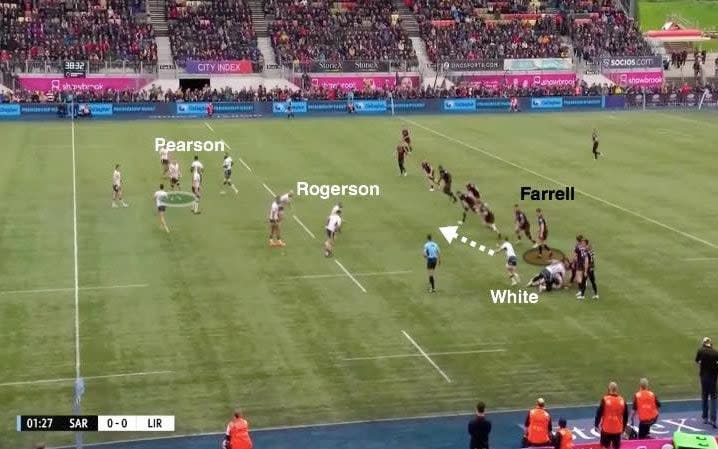
As Rogerson is stopped, Farrell bolts towards the far touchline. He is aiming to fill in to the right of Ben Earl, allowing his forwards to stay closer to the ruck:
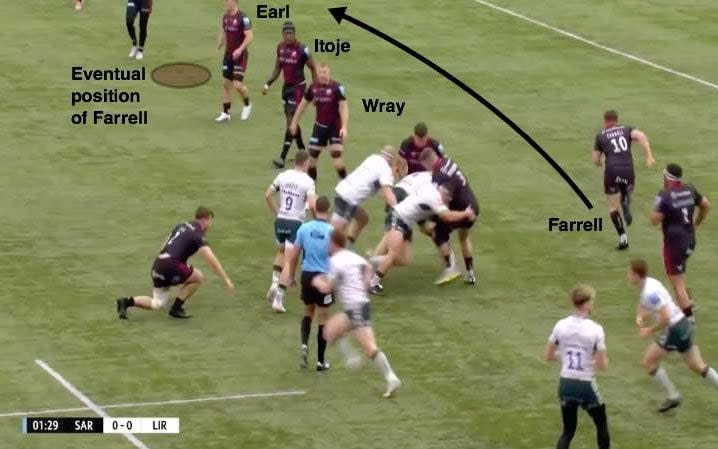
Farrell ends up sprinting around in a sling-shot motion. He identifies Pearson as the potential pivot of a wrap-around play, shuts down the space…
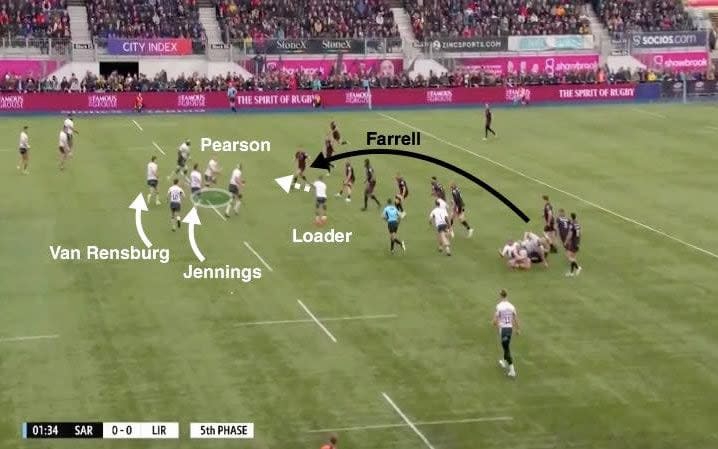
…and makes a robust tackle:
Moments later, Farrell and Nick Isiekwe combine to force a spill out of Rogerson. You can see Farrell’s left index finger pointing in celebration at the end of this clip. He clearly takes pride in setting an uncompromising tone:
Against Saints in the semi-final, Farrell starts in midfield as David Ribbans carries. Rory Hutchinson is the man to watch:

On the following phase, Farrell hunts him down. Another well-timed challenge produces a turnover:
Having earned seven tackle-turnovers from 120 tackles in the Premiership this season, according to Opta, Farrell is winning back possession once every 17 tackles. That is the best rate of any player in the Premiership.
While less dominant in the contact area, Ford is a skilful defender. His strip of Nepo Laulala was a tone-setting moment of England’s famous victory over New Zealand at the 2019 World Cup:
This season, Mateo Carreras of Newcastle Falcons tore through Ford from this scrum:
Ford retreats, though. He adopts a spot in the Sale front line…
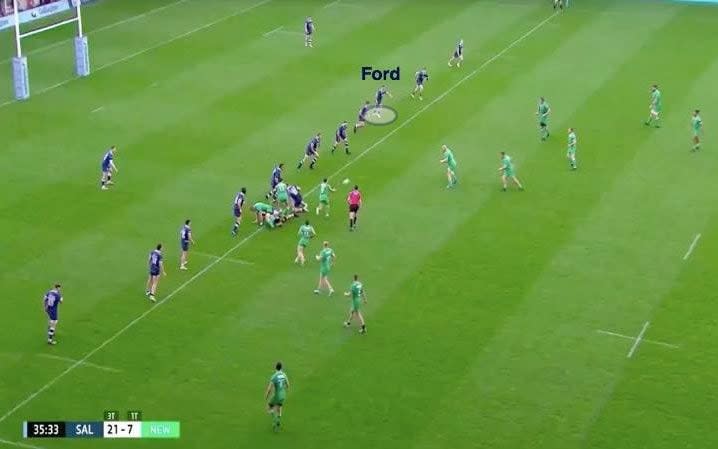
…and whips the ball away from Sebastian de Chaves:
In the semi-final defeat of Tigers, Ford and Jean-Luc du Preez helped to steal possession from James Cronin as well:
Ford is far from a speed bump, even if Farrell would be more readily associated with snarling defence.
Battle of the boot
Lastly, to kicking; another facet of this showdown. Ford has put boot to ball more often than Farrell this term, averaging 11.7 kicks in open play per 80 minutes for around 398 metres – numbers that are down on his output for Leicester over the previous two campaigns. Farrell, meanwhile, is averaging 8.6 kicks per 80 minutes for 273 metres across the 2022-23 Premiership season.
The craft of Ford can be game-defining. This second-half spiral bomb, leading to a breakdown turnover following Manu Tuilagi’s tackle and a jackal from Tom Curry, helped eke out three points for Sale:
Here, Sale set up for a box-kick from scrum-half via Gus Warr before feeding Ford to add a dash of deception. This week, Malins outlined the importance of body language for opposition wings.
“You certainly have to be alert for anything you might present to him,” Malins said of Ford. “It’s about trying to paint pictures so he doesn’t see space and closing down the space when he goes to it.”
Watch Harry Potter here. The Leicester wing actually positions himself pretty well from a scrum just outside the Sale 22. He is quick enough to press up and shut down space if Ford opts to move the ball wide, yet stationed deep enough not to present too much room over his head.
The ball is passed back into the Sale 22, so Ford cannot go directly into touch. If he does aim over the top of Potter, there is a tiny margin for error. Ford backs his judgment, and the strike is impeccable. Tigers must begin again from a line-out inside their own half:
Ford has made the spiral bomb into something of a trademark, but Farrell is becoming an effective exponent as well. He caused havoc for Wales during the Six Nations and unleashed this effort against Northampton. George Furbank was utterly confounded, and fortunate that the ball bounced beyond the corner flag to spare a 50:22:
Saracens have made a habit of picking teams off with flowing phase-play from deep this season, but they have retained the solid foundation of a sound kicking game. Here, against Exeter Chiefs on December 31, Goode fields a box-kick before feeding Farrell, who spears the ball deep into opposition territory and finds the turf for a 50:22:
Grubbers, chips and cross-field kick-passes may feature at Twickenham. These fly-halves have various weapons with which to manipulate defences.
From the tee, Ford would appear to have the edge. He has landed 22 of 24 shots at goal this Premiership season, outperforming Opta’s predictor model, which calculates outcome against expected success rate in terms of points per kick.
Ford has ‘gained’ 0.5 points per kick by this metric, the best mark of any kicker in the competition. Farrell, meanwhile, has made 57 of 72 attempts at goal in domestic action, putting him a shade over his expected success rate (+0.04 points per kick). Having battled through a tricky Six Nations, he has been more accurate of late.
The pressure of high-stakes games can be claustrophobic and crippling. Experienced fly-halves such as Farrell and Ford are supposed to thrive on these occasions as they bid to steer their teams to silverware. We are the lucky ones who get to watch another chapter of this rivalry unfold.
Match images from Premiership Rugby
Which player will finish in front – Owen Farrell or George Ford? Share your thoughts in the comments section below
Article courtesy of
Source link